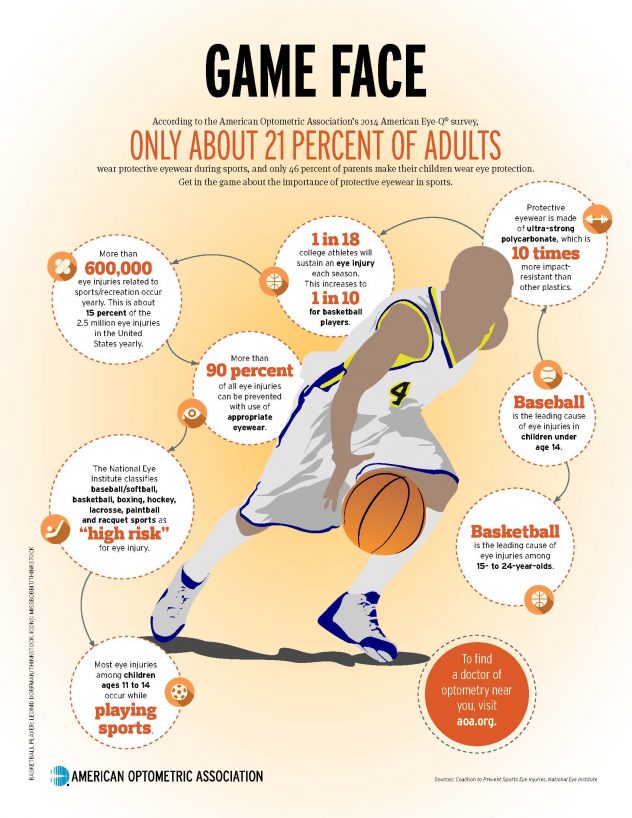
It’s true: carrots are good for your eyes! In fact, a diet rich in a variety of fruits and vegetables — especially dark leafy greens, like spinach or kale — can help keep your eyes healthy.
Tag: eye health
Simple Tips for Healthy Eyes
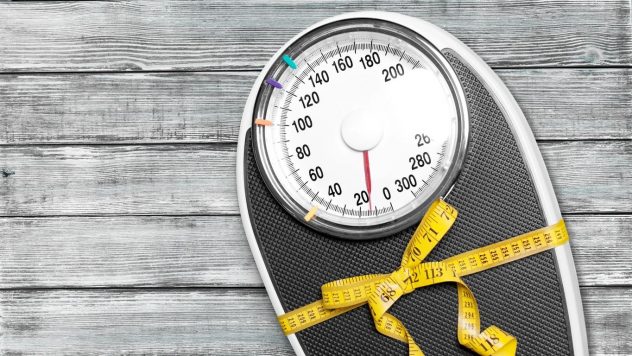
Maintain a healthy weight
Being overweight or obese increases your risk of developing diabetes and other systemic conditions, which can lead to vision loss, such as diabetic eye disease or glaucoma. If you are having trouble maintaining a healthy weight, talk to your doctor.

Wear protective eyewear.
Wear protective eyewear when playing sports or doing activities around the home. Protective eyewear includes safety glasses and goggles, safety shields, and eye guards specially designed to provide the correct protection for a certain activity. Most protective eyewear lenses are made of polycarbonate, which is 10 times stronger than other plastics. Many eye care providers sell protective eyewear, as do some sporting goods stores.
Have a Safe 4th of July

July Fourth is nearly here and everyone in Honolulu is looking forward to the fireworks.
According to the U.S. Consumer Product Safety Commission, at least five fireworks-related deaths were reported in 2018. An estimated 9,100 injuries due to fireworks were treated in hospital emergency rooms, the Centers for Disease Control and Prevention say. Of those, most injuries were from firecrackers, but sparklers and bottle rockets also were to blame. More than a third (36%) of the injuries were to children 15 years of age and under. Most of the injuries involved hands and fingers, the head (including face, eyes, and ears), legs and arms.
To help prevent eye injuries during fireworks season, we recommend the following tips to help protect and preserve eyesight during the Fourth of July holiday:
- Discuss fireworks safety with children and teens prior to the Fourth of July holiday.
- Do not allow kids to handle fireworks, and never leave them unsupervised near fireworks.
- Wear protective eyewear when lighting and handling fireworks of any kind.
- Store fireworks, matches and lighters in a secure place where children won’t find them.
- Refrain from purchasing sparklers. Heating up to 2,000 degrees or hotter, sparklers are the No. 1 cause of firework injuries requiring trips to the emergency room.
- Be aware of your surroundings and only light fireworks when family, friends and children are at a safe distance.
If an eye injury occurs, immediately seek medical attention from your local doctor of optometry or the nearest emergency room, You should refrain from rubbing their eyes or applying pressure. Don’t attempt to remove any objects that may be stuck in the eye, and avoid taking pain medications such as ibuprofen or aspirin that may thin the blood.”
Make Vision a Health Priority
With today’s medical advances, more and more people are living longer and celebrating good health: They are eating healthy foods, they are staying active, they are controlling their blood pressure and cholesterol levels, and they are not smoking.
 Practice good eye health … Make vision a health priority by seeing your eye care professional
Practice good eye health … Make vision a health priority by seeing your eye care professional
Feeling good and living life to its fullest also means taking good care of your eyes. Even if you enjoy relatively good vision now, visiting your eye care professional once a year is the best thing you can do to care for your eyes. Getting an eye exam is more important now than ever before, because as you get older, you are at higher risk of developing several age-related eye diseases and conditions, including—
- Age-related macular degeneration
- Cataract
- Diabetic retinopathy
- Glaucoma
In their early stages, these diseases often have no warning signs or symptoms. In fact, the only way to detect them before they become serious and cause vision loss is through a comprehensive dilated eye exam. Fortunately, if your eye care professional catches and treats these conditions early, he or she can protect your eyesight.
What is a dilated eye exam?
A comprehensive dilated eye exam is important to maintain and protect healthy vision. During this exam, drops are placed in the eyes to dilate or widen the pupils (the round opening in the center of the eye). The eye care professional uses a special magnifying lens to examine the retina (the light-sensitive tissue at the back of the eye) and optic nerve (the bundle of fibers that send signals from the retina to the brain) for signs of damage and other eye problems.
Take charge of your vision
In addition to seeing your eye care professional routinely, you can do the following things to protect your vision:
- Stop smoking
- Eat a diet rich in green leafy vegetables and fish
- Exercise
- Maintain normal blood pressure
- Wear sunglasses and a brimmed hat anytime you are outside in bright sunshine
- Wear safety eyewear when working around your house or playing sports
Information and resources
The National Eye Institute (NEI) is part of the National Institutes of Health and the federal government’s lead agency for vision research that leads to sight-saving treatments, and it plays a key role in reducing visual impairment and blindness. For more information, visit the NEI Website at www.nei.nih.gov
Simple Tips for Healthy Eyes: Know your family’s eye health history.
Know your family’s eye health history.
Talk to your family members about their eye health history. It’s important to know if anyone has been diagnosed with a disease or condition since many are hereditary. This information will help to determine if you are at higher risk for developing an eye disease or condition.
Keeping your eyes healthy will insure your most important sense – SIGHT!
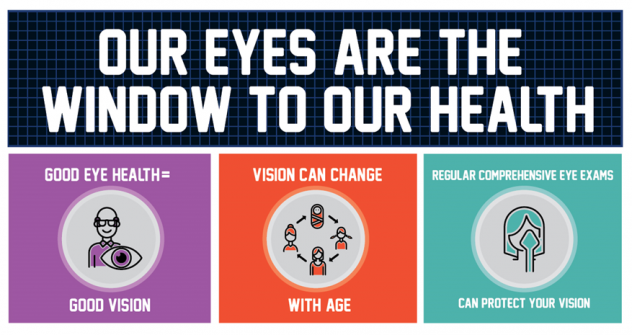
Your eye examination includes: checking the front of the eyes making sure that the cornea is healthy without tear malfunction, the internal natural lens of the eye is clear without cloudiness or cataract, the optic nerve is not damaged due to glaucoma or other factors, and the central vision of the eye is not impaired from retinal changes or macular degeneration.
Simple Tips for Healthy Eyes
Your eyes are an important part of your health. There are many things you can do to keep them healthy and make sure you are seeing your best. Follow these simple steps for maintaining healthy eyes well into your golden years.
Have a comprehensive dilated eye exam. You might think your vision is fine or that your eyes are healthy, but visiting your eye care professional for a comprehensive dilated eye exam is the only way to really be sure. When it comes to common vision problems, some people don’t realize they could see better with glasses or contact lenses. In addition, many common eye diseases such as glaucoma, diabetic eye disease, and age-related macular degeneration often have no warning signs. A dilated eye exam is the only way to detect these diseases in their early stages.
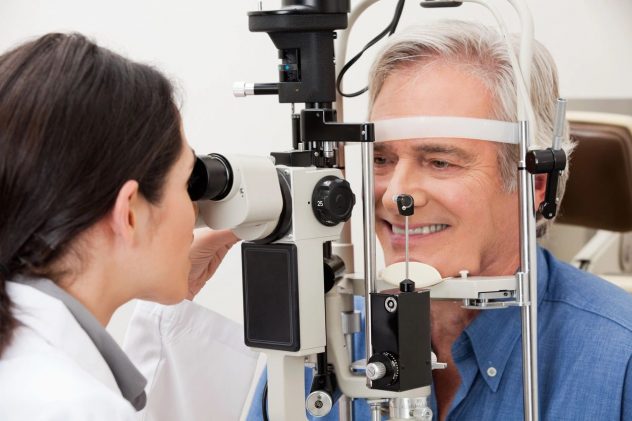
During a comprehensive dilated eye exam, your eye care professional places drops in your eyes to dilate, or widen, the pupil to allow more light to enter the eye the same way an open door lets more light into a dark room. This dilation enables your eye care professional to get a good look at the back of the eyes and examine them for any signs of damage or disease. Your eye care professional is the only one who can determine if your eyes are healthy and if you are seeing your best.
Blurry vision is not the only reason to have an eye exam
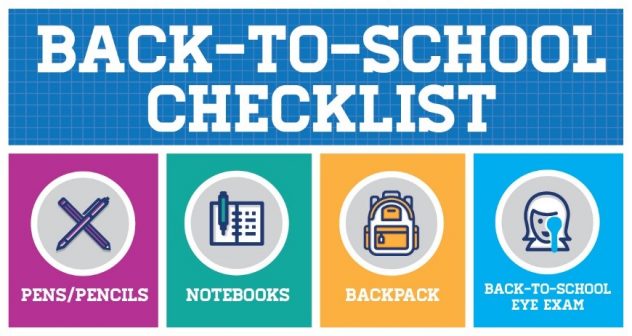 Blurry vision is not the only reason to have an eye exam. Your child could have difficulty using both eyes together, a critical reading skill, and you might not know. Back to school means it’s time to get a comprehensive eye exam. Also, much of a child’s learning is visual. How well can your child see? If you don’t know, it’s time for a comprehensive eye exam.
Blurry vision is not the only reason to have an eye exam. Your child could have difficulty using both eyes together, a critical reading skill, and you might not know. Back to school means it’s time to get a comprehensive eye exam. Also, much of a child’s learning is visual. How well can your child see? If you don’t know, it’s time for a comprehensive eye exam.
Good Eye Health = Good Vision
 Our eyes are the window to our health. The goal as we “get on in years” is to be able to stay active and vibrant. Adopting a healthy lifestyle of eating properly, exercising and yearly health evaluations including yearly eye examination help with this goal.
Our eyes are the window to our health. The goal as we “get on in years” is to be able to stay active and vibrant. Adopting a healthy lifestyle of eating properly, exercising and yearly health evaluations including yearly eye examination help with this goal.
Keep your eyes healthy
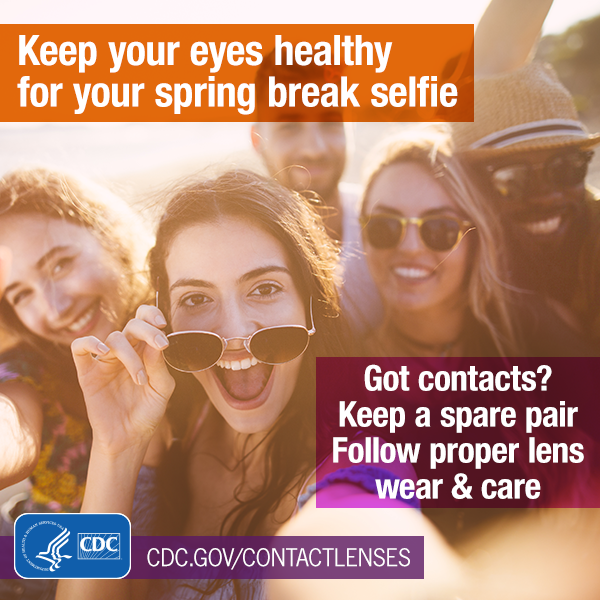
Keep your eyes healthy for your spring break selfie. Got contacts? Keep a spare pair . Follow proper lens wear and care.
Early Detection and Treatment is Key in Protecting Vision from the Effects of Glaucoma
Glaucoma affects 2.7 million people in the United States and is the second leading cause of blindness, yet understanding and awareness of the disease is low. In fact, 72 percent of Americans don’t know that glaucoma typically has no early warning signs or symptoms, according to the American Optometric Association’s (AOA) 2014 American Eye-Q® consumer survey.
Often referred to as the “sneak thief of sight,” glaucoma is a group of eye disorders that can damage the optic nerve and impair peripheral vision. If left untreated, glaucoma can lead to complete loss of sight. While the disease does not have a cure and is not preventable, it is treatable and can be detected in a comprehensive eye exam provided by your optometrist.
“A common misconception is that glaucoma only affects older adults when, in reality, it can happen at any age. In fact, it’s most commonly detected in people in their 40s,” said Dr. Inouchi. “The key is to identify and diagnose the disease early in order to promptly treat and slow the progression of vision loss.”
Americans are also largely unaware of the factors that put them at greater risk for developing glaucoma – only 13 percent of Americans know that a person’s race increases their chances for developing the disease. According to the Glaucoma Research Foundation, glaucoma is six to eight times more common in African Americans than Caucasians. Additional factors that put someone at greater risk for glaucoma include those who have a family history of glaucoma, diabetes, hypothyroidism, are over age 60 or individuals who have had severe eye trauma.
Treatment for glaucoma includes prescription eye drops and medication to lower pressure in the eyes. In some cases, laser treatment or surgery may be effective in reducing pressure.
In addition to yearly, comprehensive eye exams, Dr. Daniel Yamamoto & Dr. Tracie Inouchi suggests the following tips to help maintain overall eye health and clear, comfortable vision:
- Eat green, leafy vegetables and foods rich in nutrients like beta carotene, vitamin C and zinc to protect eyes from disease.
- Cut down on those bad habits such as smoking and consuming alcohol or excessive caffeine, which can all be harmful to the eyes.
- If you work in front of a computer, practice the 20/20/20 rule: every 20 minutes, take a 20 second break and look at something 20 feet away to help avoid digital eye strain.
- Wear sunglasses with UV-A and UV-B protection year-round.
Contact Dr. Daniel Yamamoto & Dr. Tracie Inouchi today at (808) 949-2662 to make an appointment for a comprehensive eye exam and to learn more about ways to help prevent vision loss from glaucoma.
Game Face – Stats on eye injuries while participating in sports
- The National Eye Institute classifies baseball/softball, basketball, boxing, lacrosse, hockey, paintball and racquet sports as “high risk” for eye injury.
- More than 600,00 related to sports/recreation occur every year. This is about 15% of the 2.5 million eye injuries in the United States yearly.
- 1 in 18 college athletes will sustain an eye injury each season. This increases to 1 in 10 for basketball players.
- Basketball is the leading cause of eye injuries among 15 to 24 year old.
- Baseball is the leading cause of eye injuries in children under 14 years old.
- Most eye injuries among children ages 11 to 14 occur while playing sports.
- More than 90% of all eye injuries can be prevented with the use of protective eye wear.
- Protective eye wear is made of ultra-strong polycarbonate, which is 10 times more impact resistant than other plastics.
What You Need to Know About Dry Eye
Tears Wanted
What you need to know about dry eye:
- 38% of adults experience dry eye, a lack of tears or poor quality of tears, which can cause irritated or gritty eyes, redness, burning, blurred vision.
Dry Eye can stem from:
- Age – Those 65 and older
- Gender – Particularly in women who are pregnant or experiencing menopause
- Medications or Medical Conditions – Decongestants, anti-depressants, diabetes, thyroid issues
- Environment – Conditions such smoke, wind or dry climate
- Technology – Not taking breaks from digital devices
Here are some tips to help alleviate symptoms:
- Increase the level of humidity
- Wear sunglasses to reduce exposure to wind and sun.
- Use nutritional supplements (if recommended)
- Drink 8-10 glasses of water every day
Advanced dry eye could damage and impair vision. Dr. Daniel Yamamoto & Dr. Tracie Inouchi can prescribe treatment to keep your eyes healthy.

Five Tips For a Lifetime of Healthy Vision
Here are 5 tips for a life time of healthy vision. Honolulu eye doctors, Daniel Yamamoto, O.D. and Tracie Inouchi, O.D. suggest:
- Schedule Yearly Comprehensive Exams. Seeing a doctor of optometry regularly will help keep you on the path to healthy eyes.
- Protect against UV rays. No matter the season its important to wear sunglasses.
- Give your eyes a break from digital device use. Practice the 20/20/20 rule: every 20 minutes take a 20 second break and look at something 20 feet away.
- Eat your greens. Eat five servings of fruits and vegetables – particularly the leafy green variety.
- Practice safe wear and care of your contact lenses. Keep them clean.


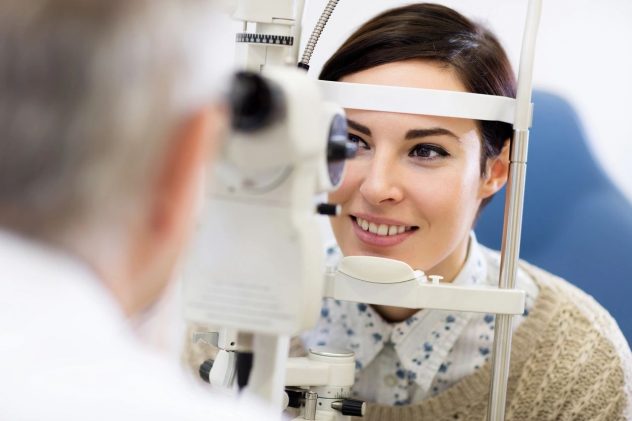 Practice good eye health … Make vision a health priority by seeing your eye care professional
Practice good eye health … Make vision a health priority by seeing your eye care professional
